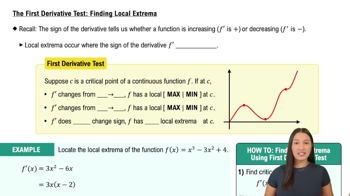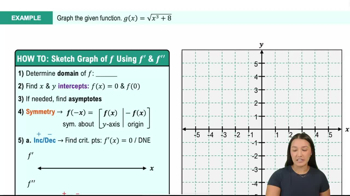Table of contents
- 0. Functions7h 52m
- Introduction to Functions16m
- Piecewise Functions10m
- Properties of Functions9m
- Common Functions1h 8m
- Transformations5m
- Combining Functions27m
- Exponent rules32m
- Exponential Functions28m
- Logarithmic Functions24m
- Properties of Logarithms34m
- Exponential & Logarithmic Equations35m
- Introduction to Trigonometric Functions38m
- Graphs of Trigonometric Functions44m
- Trigonometric Identities47m
- Inverse Trigonometric Functions48m
- 1. Limits and Continuity2h 2m
- 2. Intro to Derivatives1h 33m
- 3. Techniques of Differentiation3h 18m
- 4. Applications of Derivatives2h 38m
- 5. Graphical Applications of Derivatives6h 2m
- 6. Derivatives of Inverse, Exponential, & Logarithmic Functions2h 37m
- 7. Antiderivatives & Indefinite Integrals1h 26m
- 8. Definite Integrals4h 44m
- 9. Graphical Applications of Integrals2h 27m
- 10. Physics Applications of Integrals 2h 22m
5. Graphical Applications of Derivatives
Curve Sketching
Problem 63
Textbook Question
Local max/min of x¹⸍ˣ Use analytical methods to find all local extrema of the function ƒ(x) = x¹⸍ˣ , for x > 0 . Verify your work using a graphing utility.
 Verified step by step guidance
Verified step by step guidance1
To find the local extrema of the function \( f(x) = x^{1/x} \), first take the derivative of the function with respect to \( x \). This involves using the chain rule and the power rule.
Express \( f(x) = x^{1/x} \) as \( f(x) = e^{(1/x) \ln(x)} \) to facilitate differentiation. Differentiate \( f(x) = e^{(1/x) \ln(x)} \) using the chain rule: \( f'(x) = e^{(1/x) \ln(x)} \cdot \left( \frac{d}{dx} \left( \frac{\ln(x)}{x} \right) \right) \).
Calculate \( \frac{d}{dx} \left( \frac{\ln(x)}{x} \right) \) using the quotient rule: \( \frac{d}{dx} \left( \frac{\ln(x)}{x} \right) = \frac{x \cdot \frac{1}{x} - \ln(x) \cdot 1}{x^2} = \frac{1 - \ln(x)}{x^2} \).
Set \( f'(x) = 0 \) to find critical points: \( e^{(1/x) \ln(x)} \cdot \frac{1 - \ln(x)}{x^2} = 0 \). Since \( e^{(1/x) \ln(x)} \neq 0 \), solve \( \frac{1 - \ln(x)}{x^2} = 0 \), which simplifies to \( 1 - \ln(x) = 0 \). Therefore, \( \ln(x) = 1 \), giving \( x = e \).
Verify the nature of the critical point \( x = e \) by using the second derivative test or by analyzing the sign changes of \( f'(x) \) around \( x = e \). This will confirm whether \( x = e \) is a local maximum or minimum. Finally, use a graphing utility to visualize the function and confirm the analytical results.
 Verified video answer for a similar problem:
Verified video answer for a similar problem:This video solution was recommended by our tutors as helpful for the problem above
Video duration:
9mPlay a video:
Was this helpful?
Key Concepts
Here are the essential concepts you must grasp in order to answer the question correctly.
Critical Points
Critical points of a function occur where its derivative is zero or undefined. These points are essential for finding local maxima and minima, as they indicate where the function's slope changes. To find critical points, we first compute the derivative of the function and solve for x when the derivative equals zero.
Recommended video:

Critical Points
First Derivative Test
The First Derivative Test is a method used to determine whether a critical point is a local maximum, local minimum, or neither. By analyzing the sign of the derivative before and after the critical point, we can conclude if the function is increasing or decreasing. If the derivative changes from positive to negative, the point is a local maximum; if it changes from negative to positive, it is a local minimum.
Recommended video:

The First Derivative Test: Finding Local Extrema
Graphing Utility Verification
Using a graphing utility allows for visual confirmation of the analytical results obtained from calculus. By plotting the function, one can observe the behavior of the graph around the critical points, confirming the presence of local maxima and minima. This visual approach helps to validate the findings from the derivative tests and provides insight into the function's overall shape.
Recommended video:

Graphing The Derivative

 11:41m
11:41mWatch next
Master Summary of Curve Sketching with a bite sized video explanation from Callie
Start learning




